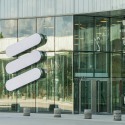
Ericsson lifted its sales targets for next year amid signs that telco investments in new 5G networks are picking up and said it was targeting a bigger role in China than it ever played during the 4G era.
The Swedish equipment maker had been aiming for revenues of between 210 and 220 billion Swedish kronor in 2020 but now expects to generate SEK230-240 billion ($23.5-24.6 billion) because of a "stronger 5G market" than previously expected and favorable currency movements. At the bottom end of the revised forecast, sales would be 9.1% higher than 2018's full year revenue number.
The upgrade comes with Ericsson anticipating a surge of 5G activity in China, where it has been investing in supply chain capacity as it tries to boost its market share.
"We want to be stronger in China in 5G than we were in 4G," said CEO Börje Ekholm during a call with analysts. "The 4G market in China is really more than 60% of the global market and we have no reason to believe 5G will be less."
Q3 2019 | Q3 2018 | YoY change | |
Net sales | 57.1 | 53.1 | 6% |
Gross income | 21.5 | 19.6 | 10% |
Gross margin | 37.7% | 36.5% | 1.2 percentage points |
R&D expernses | -9.5 | -9.4 | 1% |
Operating income | -4.2 | 3.2 | -231% |
Operating margin | -7.3% | 6.0% | -13.3 percentage points |
Net income | -6.9 | 2.7 | -356% |
Source: Ericsson. |
But the push for what Ericsson calls "strategic contracts" comes with no guarantees. Earlier this year, Finnish rival Nokia said it was reviewing its activities in China because of growing support for local vendors -- which include Huawei and ZTE -- in preference to Western firms.
Ekholm acknowledged that Ericsson was making investments in China despite uncertainty about contract awards and timing. "No awards have been made and we have no way of knowing potential market shares or price levels." Major rollout activity is likely to begin later this year or early in 2020, he said, following a deal between China Telecom and China Unicom to build a shared 5G network.
There are also signs Ericsson is bidding aggressively for new contracts as it tries to secure market share. In Norway, the company recently saw off competition from Huawei to become Telia's sole supplier of mobile infrastructure. Under that contract, it will replace 4G equipment currently provided by the Chinese vendor.
Swap-out costs are at least partly responsible for the pressure on gross margins that Ericsson has seen, Ekholm confirmed. "There are typically costs for changing equipment and service-related costs," he said. "Historically there are typically tough margins in the beginning as you roll out and then you catch up over the contract period."
After stripping out a license settlement cost, the gross margin at Ericsson's networks business shrank 0.8 percentage points sequentially in the recent third quarter, although the reported figure for the overall business rose to 37.8% from 36.9% a year earlier.
Unfortunately, operating profits were hammered by charges relating to a $1 billion US fine that Ericsson expects to pay for corruption in several countries under previous management. That sent the operating margin in the quarter to -7.3%, from 6% a year earlier. Ekholm said he was "confident" of hitting a 2020 target of 10%. Moreover, despite efforts to increase market share, Ericsson is now guiding for a margin of between 12% and 14% in 2022, compared with an earlier target of more than 12%.
Total sales for the third quarter were up 6% year-on-year, to SEK57.1 billion ($5.8 billion), with Ericsson citing an organic increase of 3%.
The company slumped to a net loss of SEK6.9 billion ($710 million), compared with a profit of SEK2.7 billion ($280 million) a year earlier, after setting aside about SEK11.5 billion ($1.2 billion) for payments to US authorities and related costs.
Nevertheless, the update on the sales outlook sent Ericsson's share price up 6%, to SEK88.40 ($9.05), when the market opened in Stockholm this morning, although it is down from a high point of SEK96.74 ($9.90) in the last 12 months.
Want to know more about 5G? Check out our dedicated 5G content channel here on
Light Reading.
At non-network areas of the business, the company's long-suffering digital services unit delivered 10% year-on-year growth in sales, to SEK9.9 billion ($1.01 billion), and narrowed its operating loss to SEK700 million ($71.7 million) from SEK1.8 billion ($180 million) a year earlier.
The company has been exiting or renegotiating unprofitable contracts and has now dealt with 29 of the 45 agreements it originally targeted in 2017. "We are resolving contracts one by one and what is encouraging is the strong development in underlying business," said Ekholm. "We did not target the fastest possible turnaround in digital services. The priority was to build a strong unit and create a create a strong product portfolio." The unit remains on course for a low single-digit operating margin next year, he said.
There were also some good signs in managed services, with third-quarter operating income rising to SEK600 million ($61.4 million), from SEK400 million ($41 million) a year earlier, despite a dip in sales. Revenues were down 2% on a reported basis, to SEK6.4 billion ($660 million), and shrank 5% organically. Ericsson blamed the decline on "earlier communicated customer contract exits" under its turnaround strategy.
Figures published today also showed that -- after a long period of layoffs -- Ericsson appears to be hiring once again. Some 1,131 employees joined in the quarter, giving Ericsson 95,887 in total.
Staff numbers are down from 111,464 at the end of 2016, just before Ekholm joined as CEO.
Related posts:
— Iain Morris, International Editor, Light Reading
About the Author(s)
You May Also Like












